Space station
A space station, also known as an orbital station or an orbital space station, is a spacecraft capable of supporting a human crew in orbit for an extended period of time, and is therefore a type of space habitat. It lacks major propulsion or landing systems. Stations must have docking ports to allow other spacecraft to dock to transfer crew and supplies.
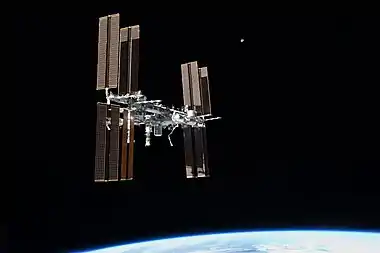
The purpose of maintaining an orbital outpost varies depending on the program. Space stations have most often been launched for scientific purposes, but military launches have also occurred. As of 2021, one fully operational and permanently inhabited space station is in low Earth orbit: the International Space Station (ISS), which is used to study the effects of spaceflight on the human body as well as to provide a location to conduct a greater number and longer length of scientific studies than is possible on other space vehicles. China, India, Russia, and the U.S., as well as Bigelow Aerospace and Axiom Space, are all planning other stations for the coming decades.
History
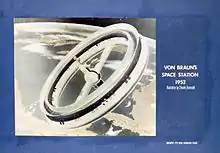
The first mention of anything resembling a space station occurred in Edward Everett Hale's 1869 "The Brick Moon".[1] The first to give serious, scientifically grounded consideration to space stations were Konstantin Tsiolkovsky and Hermann Oberth about two decades apart in the early 20th century.[2] In 1929 Herman Potočnik's The Problem of Space Travel was published, the first to envision a "rotating wheel" space station to create artificial gravity.[1] Conceptualized during the Second World War, the "sun gun" was a theoretical orbital weapon orbiting Earth at a height of 8,200 kilometres (5,100 mi). No further research was ever conducted.[3] In 1951, Wernher von Braun published a concept for a rotating wheel space station in Collier's Weekly, referencing Potočnik's idea. However, development of a rotating station was never begun in the 20th century.[2]
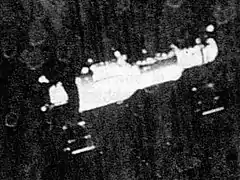
During the latter half of the 20th century, the Soviet Union developed and launched the world's first space station, Salyut 1.[4] The Almaz and Salyut series were eventually joined by Skylab, Mir, and Tiangong-1 and Tiangong-2. The hardware developed during the initial Soviet efforts remains in use, with evolved variants comprising a considerable part of the ISS, orbiting today. Each crew member stays aboard the station for weeks or months, but rarely more than a year. Starting with the ill-fated flight of the Soyuz 11 crew to Salyut 1, all recent human spaceflight duration records have been set aboard space stations. The duration record for a single spaceflight is 437.75 days, set by Valeri Polyakov aboard Mir from 1994 to 1995. As of 2016, four cosmonauts have completed single missions of over a year, all aboard Mir. The last military-use space station was the Soviet Salyut 5, which was launched under the Almaz program and orbited between 1976 and 1977.[5]
Early monolithic stations (1971–1986)
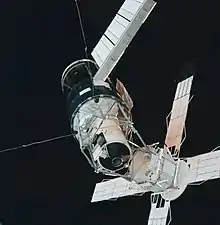
Early stations were monolithic designs that were constructed and launched in one piece, generally containing all their supplies and experimental equipment. A crew would then be launched to join the station and perform research. After the supplies had been used up, the station was abandoned.[4]
The first space station was Salyut 1, which was launched by the Soviet Union on April 19, 1971. The earlier Soviet stations were all designated "Salyut", but among these there were two distinct types: civilian and military. The military stations, Salyut 2, Salyut 3, and Salyut 5, were also known as Almaz stations.[6]
The civilian stations Salyut 6 and Salyut 7 were built with two docking ports, which allowed a second crew to visit, bringing a new spacecraft with them; the Soyuz ferry could spend 90 days in space, at which point it needed to be replaced by a fresh Soyuz spacecraft.[7] This allowed for a crew to man the station continually. The American Skylab (1973-1979) was also equipped with two docking ports, like second-generation stations, but the extra port was never utilized. The presence of a second port on the new stations allowed Progress supply vehicles to be docked to the station, meaning that fresh supplies could be brought to aid long-duration missions. This concept was expanded on Salyut 7, which "hard docked" with a TKS tug shortly before it was abandoned; this served as a proof-of-concept for the use of modular space stations. The later Salyuts may reasonably be seen as a transition between the two groups.[6]
Mir (1986–2001)
.jpg.webp)
Unlike previous stations, the Soviet space station Mir had a modular design; a core unit was launched, and additional modules, generally with a specific role, were later added to that. This method allows for greater flexibility in operation, as well as removing the need for a single immensely powerful launch vehicle. Modular stations are also designed from the outset to have their supplies provided by logistical support craft, which allows for a longer lifetime at the cost of requiring regular support launches.[8]
Modules are still being developed based on the design and capabilities of Mir.
Tiangong 1 and Tiangong 2 (2011–2019)
China's first space laboratory, Tiangong-1 was launched in September 2011.[9] The uncrewed Shenzhou 8 then successfully performed an automatic rendezvous and docking in November 2011. The crewed Shenzhou 9 then docked with Tiangong-1 in June 2012, the crewed Shenzhou 10 in 2013. A second space laboratory Tiangong-2 was launched in September 2016, while a plan for Tiangong-3 was merged with Tiangong-2.[10]
In May 2017, China informed the United Nations Office for Outer Space Affairs that Tiangong-1's altitude was decaying and that it would soon reenter the atmosphere and break up.[10] The reentry was projected to occur in late March or early April 2018.[11] According to the China Manned Space Engineering Office, Tiangong-1 reentered over the South Pacific Ocean, northwest of Tahiti, on 2 April 2018 at 00:15 UTC.[12][13][14][15][16]
In July 2019 the China Manned Space Engineering Office announced that it was planning to deorbit Tiangong-2 in the near future, but no specific date was given.[17] The station subsequently made a controlled reentry on 19 July and burned up over the South Pacific Ocean.[18]
Current
ISS (1998–present)

The ISS is divided into two main sections, the Russian Orbital Segment (ROS) and the US Orbital Segment (USOS). The first module of the International Space Station, Zarya, was launched in 1998.[19]
The Russian Orbital Segment's "second-generation" modules were able to launch on Proton, fly to the correct orbit, and dock themselves without human intervention.[20] Connections are automatically made for power, data, gases, and propellants. The Russian autonomous approach allows the assembly of space stations prior to the launch of crew.
The Russian "second-generation" modules are able to be reconfigured to suit changing needs. As of 2009, RKK Energia was considering the removal and reuse of some modules of the ROS on the Orbital Piloted Assembly and Experiment Complex after the end of mission is reached for the ISS.[21] However, in September 2017 the head of Roscosmos said that the technical feasibility of separating the station to form OPSEK had been studied, and there were now no plans to separate the Russian segment from the ISS.[22]
In contrast, the main US modules launched on the Space Shuttle and were attached to the ISS by crews during EVAs. Connections for electrical power, data, propulsion, and cooling fluids are also made at this time, resulting in an integrated block of modules that is not designed for disassembly and must be deorbited as one mass.[23]
The Axiom Orbital Segment is a planned commercial segment to be added to the ISS starting in the mid 2020s. Axiom Space gained NASA approval for the venture in January 2020. Up to three Axiom modules will attach to the International Space Station. The first module could be launched no later than 2024 and will be docked to the forward port of Harmony, requiring relocation of the PMA-2. Axiom Space plans to attach up to two additional modules to its first core module, and send private astronauts to inhabit the modules. The modules could one day detach into the Axiom Station in a manner similar to Russia's proposed OPSEK.[24]
Planned projects
These space stations have been announced by their host entity and are currently in planning, development or production. The launch date listed here may change as more information becomes available.
| Name | Entity | Program | Crew size | Launch date | Remarks |
|---|---|---|---|---|---|
| Large modular space station | Tiangong | 3 |
2021–2022[25] | ||
| Space Complex Alpha | Bigelow Commercial Space Station | 12[26] |
TBD | ||
| Space Complex Bravo | 24[27] |
TBD | |||
| Lunar Gateway | Artemis | 4 |
2024[28] | Intended to serve as a science platform and as a staging area for the lunar landings of NASA's Artemis program and follow-on human mission to Mars. | |
| Axiom Station | TBD |
2020s | Axiom and a team of companies won NASA's NextSTEP award to develop a node module to add to the International Space Station by the second half of 2024, which Axiom plans to follow with two additional modules and a power and thermal module that will eventually allow the set of modules to detach from the ISS (about a year before ISS's end of life) and continuously operate as a stand-alone space station.[29][30] | ||
| TBD | Indian Human Spaceflight Programme | 3 |
~2030[31][32][33][34] | ISRO chairman K. Sivan announced in 2019 that India will not join the International Space Station and will instead build a 20 tonne space station on its own.[35] It is intended to be built in the next 5–7 years,[36] | |
| Lunar Orbital Station[37] (LOS) |
TBD |
after 2030[38] | |||
| Stasiun Luar Angkasa Republik Indonesia (SLARI) | TBD |
2030-2035[39] |
Canceled projects
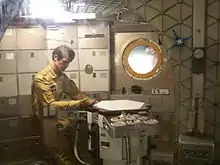
Most of these stations were canceled due to financial difficulties. However, Mir-2 was merged to Freedom and formed the basis of the International Space Station.
| Name | Entity | Crew size | Remarks |
|---|---|---|---|
| Manned Orbiting Laboratory 1–7 | 2[40] | Canceled due to excessive costs in 1969[41] | |
| Skylab B | 3[42] | Constructed, but launch canceled due to lack of funding.[43] Now a museum piece. | |
| OPS-4 | Constructed but never launched, due to cancellation of the Almaz program. | ||
| Freedom | 14–16[44] | Merged to form the basis of the International Space Station | |
| Mir-2 | 2[45] | ||
| Galaxy | Robotic[46] | Canceled due to rising costs and ability to ground test key Galaxy subsystems[47] | |
| Almaz commercial | 4 or more | Lack of funds. | |
| OPSEK | More than 2 | Canceled in 2017. OPSEK components will instead remain attached to the ISS. |
Architecture
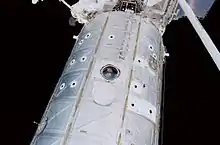
Two types of space stations have been flown: monolithic and modular. Monolithic stations consist of a single vehicle and are launched by one rocket. Modular stations consist of two or more separate vehicles that are launched independently and docked on orbit. Modular stations are currently preferred due to lower costs and greater flexibility. Both types can be refueled by cargo craft, such as Progress.
A space station is a complex vehicle that must incorporate many interrelated subsystems, including structure, electrical power, thermal control, attitude determination and control, orbital navigation and propulsion, automation and robotics, computing and communications, environmental and life support, crew facilities, and crew and cargo transportation. Stations must serve a useful role, which drives the capabilities required.
Materials
Space stations are often made from durable materials that have to weather space radiation, internal pressure, micrometeoroids, and thermal effects of the sun and cold temperatures for very long periods of time. They are typically made from stainless steel, titanium and high-quality aluminum alloys, with layers of insulation such as Kevlar as a ballistics shield protection.[48]
Habitability
The space station environment presents a variety of challenges to human habitability, including short-term problems such as the limited supplies of air, water and food and the need to manage waste heat, and long-term ones such as weightlessness and relatively high levels of ionizing radiation. These conditions can create long-term health problems for space-station inhabitants, including muscle atrophy, bone deterioration, balance disorders, eyesight disorders, and elevated risk of cancer.[49]
Future space habitats may attempt to address these issues, and could be designed for occupation beyond the weeks or months that current missions typically last. Possible solutions include the creation of artificial gravity by a rotating structure, the inclusion of radiation shielding, and the development of on-site agricultural ecosystems. Some designs might even accommodate large numbers of people, becoming essentially "cities in space" where people would reside semi-permanently. For now, no space station suitable for long-term human residence has ever been built, since the current launch costs for even a small station are not economically or politically viable.[50]
Environmental microbiology
Molds that develop aboard space stations can produce acids that degrade metal, glass and rubber. Despite an expanding array of molecular approaches for detecting microorganisms, rapid and robust means of assessing the differential viability of the microbial cells, as a function of phylogenetic lineage, remain elusive.[51]
In fiction
Space stations, sometimes referred to as star bases, are a common trope in science fiction. Notable works they appear in include TV shows Babylon 5 and Star Trek: Deep Space Nine, among others. Typically they act as drydocks, battle stations or trading outposts.[52]
See also
References
- Mann, Adam (January 25, 2012). "Strange Forgotten Space Station Concepts That Never Flew". Wired. Retrieved January 22, 2018.
- "The First Space Station". Boys' Life. September 1989. p. 20.
- "Science: Sun Gun". Time. July 9, 1945. Archived from the original on May 21, 2013. Retrieved September 13, 2011.
- Ivanovich, Grujica S. (2008). Salyut – The First Space Station: Triumph and Tragedy. Springer Science+Business Media. ISBN 978-0-387-73973-1. Retrieved 1 February 2018.
- Russian Space Stations (wikisource)
- Chladek, Jay (2017). Outposts on the Frontier: A Fifty-Year History of Space Stations. University of Nebraska Press. ISBN 978-0-8032-2292-2. Retrieved 1 February 2018.
- D.S.F. Portree (1995). "Mir Hardware Heritage" (PDF). NASA. Archived from the original (PDF) on 7 September 2009. Retrieved 30 November 2010.
- Hall, R., ed. (2000). The History of Mir 1986–2000. British Interplanetary Society. ISBN 978-0-9506597-4-9.
- Barbosa, Rui. "China launches TianGong-1 to mark next human space flight milestone". NASASpaceflight.com.
- Dickinson, David (10 November 2017). "China's Tiangong 1 Space Station to Burn Up". Sky & Telescope. Retrieved 8 February 2018.
- Byrd, Deborah (March 7, 2018). "China's Tiangong-1 due for uncontrolled re-entry, soon". EarthSky. Retrieved 7 March 2018.
- "Tracking and Impact Prediction". Space-Track.Org. JFSCC/J3. 1 April 2018. Retrieved 1 April 2018.
- 18 Space Control Squadron. "18 SPCS on Twitter". Twitter. Retrieved 2 April 2018.
UPDATE: #JFSCC confirmed #Tiangong1 reentered the atmosphere over the southern Pacific Ocean at ~5:16 p.m. (PST) April 1 in an uncontrolled manner. For details see http://www.space-track.org @US_Stratcom @usairforce @AFSpaceCC @30thSpaceWing @PeteAFB @SpaceTrackOrg
- "Tiangong-1 reenters the atmosphere". cmse.gov.cn. China Manned Space. 2 April 2018. Retrieved 2 April 2018.
- Staff (1 April 2018). "Tiangong-1: Defunct China space lab comes down over South Pacific". BBC News. Retrieved 1 April 2018.
- Chang, Kenneth (1 April 2018). "China's Tiangong-1 Space Station Has Fallen Back to Earth Over the Pacific". The New York Times. Retrieved 1 April 2018.
- Jones, Andrew (12 July 2019). "China set to carry out controlled deorbiting of Tiangong-2 space lab". SpaceNews. Retrieved 17 July 2019.
- Liptak, Andrew (20 July 2019). "China has deorbited its experimental space station". The Verge. Retrieved 21 July 2019.
- "History and Timeline of the ISS". Center for the Advancement of Science in Space. Retrieved 8 February 2018.
- "Mechanical and Aerospace Engineering" (PDF). Usu.edu. Retrieved 2012-08-13.
- Zak, Anatoly (22 May 2009). "Russia 'to save its ISS modules'". BBC News. Retrieved 23 May 2009.
- Foust, Jeff (25 September 2017). "International partners in no rush regarding future of ISS". SpaceNews. Retrieved 26 October 2017.
- Thomas Kelly; et al. (2000). Engineering Challenges to the Long-Term Operation of the International Space Station. National Academies Press. pp. 28–30. ISBN 978-0-309-06938-0.
- "NASA selects Axiom Space to build commercial space station module". SpaceNews. 2020-01-28. Retrieved 2020-09-18.
- "China to begin construction of manned space station in 2019". Reuters. 27 April 2017. Retrieved 1 February 2018.
- Kenric Ward (2 February 2011). "Nevada Aerospace Company Aims for Florida: Bigelow eyes launch of commercial space stations from Cape Canaveral". Sunshine State News.
- Tim O'Reiley. "Las Vegas entrepreneur wants to upgrade space modules". Las Vegas Review-Journal. Retrieved 8 February 2012.
- "Report No. IG-21-004: NASA's Management of the Gateway Program for Artemis Missions" (PDF). OIG. NASA. 10 November 2020. pp. 5–7. Retrieved 28 December 2020.
- "NASA selects Axiom Space to build commercial space station module". SpaceNews.com. 2020-01-28. Retrieved 2020-02-14.
- Colangelo, Anthony. "Episode T+147: Mike Suffredini, President & CEO of Axiom". Main Engine Cut Off. Retrieved 2020-02-14.
- "India plans to launch space station by 2030". Engadget. June 16, 2019. Retrieved June 18, 2019.
- "ISRO Looks Beyond Manned Mission; Gaganyaan Aims to Include Women".
- "India eying an indigenous station in space". The Hindu Business Line. June 13, 2019. Retrieved June 18, 2019.
- "ISRO Chairman announces details of Gaganyaan, Chandrayaan-2 and Missions to Sun& Venus India to have its own space station, says Dr K Sivan". Press Information Bureau. 13 June 2019. Retrieved 18 June 2019.
- "India planning to have own space station: ISRO chief". The Economic Times.
- "India's own space station to come up in 5–7 years: Isro chief – Times of India". The Times of India. Retrieved 2019-06-13.
- Ahatoly Zak. "Lunar Orbital Station, LOS". Russian Space Web. Retrieved 11 February 2012.
- Xinhua (28 April 2012). "Russia unveils space plan beyond 2030". english.cntv.cn. China Central Television. Archived from the original on 6 October 2014. Retrieved 2 April 2018.
- Riza Miftah Muharram (August 1, 2015). "Stasiun Luar Angkasa Republik Indonesia (SLARI) Bakal Dibangun di 2030". Info Astronomy (in Indonesian). Retrieved 1 August 2015.
- Collins, Martin, ed. (2007). After Sputnik: 50 Years of the Space Age. New York: Smithsonian Institution in association with Harper-Collins Publishers. p. 93. ISBN 978-0-06-089781-9.
- "Spaceflight :The International Space Station and Its Predecessors". centennialofflight.net. Retrieved 22 January 2012.
- Shayler, David; Burgess, Colin (2007). NASA'S scientist-astronauts. Nasa's Scientist-Astronauts. Springer. p. 280. Bibcode:2006nasa.book.....S. ISBN 978-0-387-21897-7.
- astronautix.com. "Skylab B". astronautix.com. Archived from the original on 31 January 2012. Retrieved 1 January 2012.
- "Space Station Freedom". Encyclopedia Astronautica. Archived from the original on 11 June 2012. Retrieved 24 June 2012.
- "ISS Elements: Service Module ("Zvezda")". spaceref.com. Retrieved 24 June 2012.
- Dan Cohen. "Developing a Galaxy". Bigelow Aerospace, LLC. Archived from the original on 24 November 2007. Retrieved 23 November 2007. (page has been taken down, link is to an archived version)
- SPACE.com Staff. "Bigelow Aerospace Fast-Tracks Manned Spacecraft | Space.com". space.com. Retrieved 4 January 2012.
- http://en.roscosmos.ru/202/
- Chang, Kenneth (27 January 2014). "Beings Not Made for Space". New York Times. Retrieved 27 January 2014.
- "Space Settlements: A Design Study". NASA. 1975. Retrieved 10 February 2018.
- Trudy E. Bell (2007). "Preventing "Sick" Spaceships".
- Gary Westfahl (2005). The Greenwood Encyclopedia of Science Fiction and Fantasy: Themes, Works, and Wonders. Greenwood Publishing Group. pp. 926, 1239. ISBN 978-0-313-32953-1.
Bibliography
- Chladek, Jay (2017). Outposts on the Frontier: A Fifty-Year History of Space Stations. University of Nebraska Press. ISBN 978-0-8032-2292-2.
- Haeuplik-Meusburger: Architecture for Astronauts – An Activity based Approach. Springer Praxis Books, 2011, ISBN 978-3-7091-0666-2.
- Grujica S. Ivanovich (July 7, 2008). Salyut: the first space station: triumph and tragedy. Praxis. p. 426. ISBN 978-0-387-73585-6.
- Neri Vela, Rodolfo (1990). Manned space stations" Their construction, operation and potential application. Paris: European Space Agency SP-1137. ISBN 978-92-9092-124-0.
External links
- Read Congressional Research Service (CRS) Reports regarding Space Stations
- ISS - on Russian News Agency TASS Official Infographic(in English)
- "Giant Doughnut Purposed as Space Station", Popular Science, October 1951, pp. 120–121; article on the subject of space exploration and a space station orbiting earth

.jpg.webp)